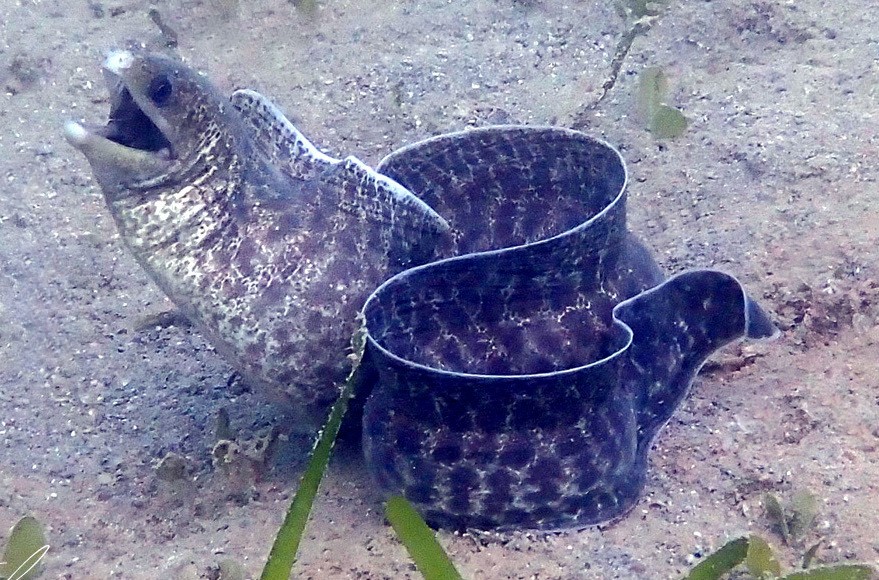GYMNOTHORAX PSEUDOTHYRSOIDEUS - (BLEEKER, 1853)
Picture courtesy of: Johan Bas
Actinopterygii (Gigaclass) > Actinopteri (Class) > Teleostei (Subclass) > Elopomorpha (Superorder) > Anguilliformes (Order) > Muraenoidei (Suborder) > Muraenidae (Family) > Muraeninae (Subfamily) > Gymnothorax (Genus)
Fausse murène tacheté, False spotted moray, Mottled moray-eel, Amime-utsubo, アミメウツボ, 淡網紋裸胸鯙, 密點裸胸鱔,
Synonymes
Gymnothorax makassariensis (Bleeker, 1863)
Lycodontis pseudothyrsoidea (Bleeker, 1853)
Muraena pseudothyrsoidea (Bleeker, 1853)
------------------------------
Description
Vertebrae predorsal: 3-5 (usually: 5), preanal: 53-61 (usually: 55), total: 122-136 (usually: 128). Preanal length: 1.9-2.1 in TL, head long: 6.4-8.0 in TL, body depth at gill opening: 10-20 in TL, and body depth at anus: 12-21 in TL. Snout length: 5.0-6.1 in HL, upper jaw: 2.1-2.8 in HL, and eye diameter: 7.6-12.0 in HL. Teeth long and slender, some long canines; Intermaxillary teeth in 3 rows, with 3 long median fangs; Maxillary teeth biserial anteriorly in juveniles, uniserial in adults; Vomerine teeth uniserial; Dentary teeth uniserial, plus 4 large inner anterior teeth. Max. length: 80.0 cm TL. Depth range: 0 - 68 m, usually: 0 - 20 m.
Color
Body grey or brown, with pattern of dark blotches formed by aggregations of smaller dark spots (on head, body and fins), the narrow interspaces appearing as diffuse pale yellow reticulum; Lower jaw and abdomen paler; Fins of juveniles with narrow pale margins.
Etymology
Gymnothorax: from Greek, gymnos = naked + from Greek, thorax, -akos = breast. The genus was created in 1795 by Bloch who indicated: "The fishes of this genus are recognized by the fact that they have no pectoral fins". This characteristic is one of the main marks of the genus, allowing to distinguish it from the eels in which Linnaeus classified the moray eels. The name of the genus thus refers explicitly to the absence of pectoral fins = chest without fins.
pseudothyrsoideus: from Greek, pseudes = false + from Greek, thyrsus = a staff tipped with a pine cone and sometimes twined with ivy leaves, borne by Dionysus and his votaries. Referring to white fine reticulations “forming polygonal meshes” and/or English translation of its Chinese vernacular name, “flowery club” although it may resemble Gymnothorax thyrsoideus, such an appearance is false.
Original description: Muraena pseudothyrsoidea Bleeker, 1853 - Type locality: Makassar, Sulawesi, Indonesia.
Distribution
Indo-West Pacific: East Africa, Persian Gulf and Seychelles, east to Philippines, New Guinea, Samoa and Marquesas Islands, north to southern Korea and Japan, south to Bunbury (Western Australia), southern New South Wales (Australia), and New Caledonia.
Biology
Found in shallow reefs, including tidepools and in turbid waters with muddy substrates. Hybridizes with Gymnothorax reevesii (Richardson, 1845).
Actinopterygii (Gigaclass) > Actinopteri (Class) > Teleostei (Subclass) > Elopomorpha (Superorder) > Anguilliformes (Order) > Muraenoidei (Suborder) > Muraenidae (Family) > Muraeninae (Subfamily) > Gymnothorax (Genus)
Fausse murène tacheté, False spotted moray, Mottled moray-eel, Amime-utsubo, アミメウツボ, 淡網紋裸胸鯙, 密點裸胸鱔,
Synonymes
Gymnothorax makassariensis (Bleeker, 1863)
Lycodontis pseudothyrsoidea (Bleeker, 1853)
Muraena pseudothyrsoidea (Bleeker, 1853)
------------------------------
Description
Vertebrae predorsal: 3-5 (usually: 5), preanal: 53-61 (usually: 55), total: 122-136 (usually: 128). Preanal length: 1.9-2.1 in TL, head long: 6.4-8.0 in TL, body depth at gill opening: 10-20 in TL, and body depth at anus: 12-21 in TL. Snout length: 5.0-6.1 in HL, upper jaw: 2.1-2.8 in HL, and eye diameter: 7.6-12.0 in HL. Teeth long and slender, some long canines; Intermaxillary teeth in 3 rows, with 3 long median fangs; Maxillary teeth biserial anteriorly in juveniles, uniserial in adults; Vomerine teeth uniserial; Dentary teeth uniserial, plus 4 large inner anterior teeth. Max. length: 80.0 cm TL. Depth range: 0 - 68 m, usually: 0 - 20 m.
Color
Body grey or brown, with pattern of dark blotches formed by aggregations of smaller dark spots (on head, body and fins), the narrow interspaces appearing as diffuse pale yellow reticulum; Lower jaw and abdomen paler; Fins of juveniles with narrow pale margins.
Etymology
Gymnothorax: from Greek, gymnos = naked + from Greek, thorax, -akos = breast. The genus was created in 1795 by Bloch who indicated: "The fishes of this genus are recognized by the fact that they have no pectoral fins". This characteristic is one of the main marks of the genus, allowing to distinguish it from the eels in which Linnaeus classified the moray eels. The name of the genus thus refers explicitly to the absence of pectoral fins = chest without fins.
pseudothyrsoideus: from Greek, pseudes = false + from Greek, thyrsus = a staff tipped with a pine cone and sometimes twined with ivy leaves, borne by Dionysus and his votaries. Referring to white fine reticulations “forming polygonal meshes” and/or English translation of its Chinese vernacular name, “flowery club” although it may resemble Gymnothorax thyrsoideus, such an appearance is false.
Original description: Muraena pseudothyrsoidea Bleeker, 1853 - Type locality: Makassar, Sulawesi, Indonesia.
Distribution
Indo-West Pacific: East Africa, Persian Gulf and Seychelles, east to Philippines, New Guinea, Samoa and Marquesas Islands, north to southern Korea and Japan, south to Bunbury (Western Australia), southern New South Wales (Australia), and New Caledonia.
Biology
Found in shallow reefs, including tidepools and in turbid waters with muddy substrates. Hybridizes with Gymnothorax reevesii (Richardson, 1845).
Similar species
Gymnothorax undulatus (Lacepède, 1803) - Reported from New caledonia.
Last update: 6, September 2024
Gymnothorax undulatus (Lacepède, 1803) - Reported from New caledonia.
Last update: 6, September 2024
